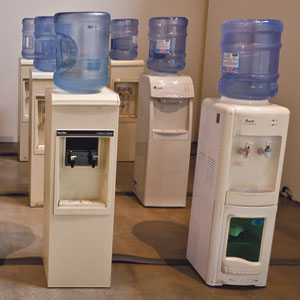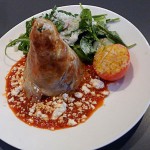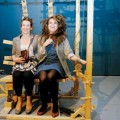Those of us not blessed with jobs as test pilots, deep-sea divers or street mimes spend most of our lives in offices, where we are privileged—or condemned—to muse on the futility of the human condition.
My cubicle—if one partition wall maketh a true cubicle—can be found in close proximity to a copier that daily exacts terrible tributes from all who dare use it. Curses, deprecations and pleas can be heard as the machine steadfastly refuses to accept its assigned chores, protesting instead that it is missing some vital piece of properly sized paper or needs its fusing oil unit replaced. Banging, rattling, slamming, sometimes kicking follow, all to little avail.
Some of the spirit of this helpless searching for shards of meaning and job satisfaction in Sisyphean challenges informs a new group show called ‘The Office’ at the San Jose Institute of Contemporary Art. Eleven artists have contributed works that either comment on or repurpose the materials and rituals of the workaday world.
Jonn Herschend’s conceptual piece Proposal for Copy Machine Location Change makes use of the gallery’s own copier, moving it into the public realm, where it occasionally spits out documents detailing future artistic endeavors. It’s more than a readymade in the Dada sense; it’s functional art at its best. At least, it seems to work better than the machine by my desk.
Some of the artists grasp the mundane and present it in new and striking ways. Kirk Crippens’ five large archival pigment prints of office potted plants focus on what is often overlooked in our daily rounds. These token bits of greenery, attempting to flourish in a fluorescent environment, appear especially forlorn under Crippens’ pitiless gaze. One spider plant sits atop a metal canister that comes with a warning label about its toxicity. No wonder the underwatered leaves droop, curl and brown. Are the employees next?
In Drift, an exquisite array of 15 small framed pieces, Alison Foshee uses staples, straight and kinked, minutely applied to paper, to create tiny metallic feathers caught in mid-waft as if shaken loose from a mechanical bird. The results are as beautiful as the repetitive process must have been numbing.
Equally as meticulous are Jill Sylvia’s ledger-paper cutouts. With a fine blade, she has precisely eliminated the informational spaces of an accounting book, leaving a lacy, see-through grid, like a rectilinear doily. Here is the superstructure of capitalism with no substance—a perfect metaphor for the financial meltdown.
Also recycling (or maybe liberating) office supplies, Mitra Fabian has connected scores of binder clips and draped them on the high back wall of the gallery in descending swags. From a distance, they look like cracks in an ancient rock face; close up, they seem more like a sagging organic organizational chart.
Once we were promised a “paperless office,’ clearly a lie. Instead, paper continues to proliferate. Penny Young takes advantage of an endless supply to create a huge Clerical Vortex, a cyclone twister sculpture spun together from miles and miles of shredded paper. We’re not in the Kansas branch office anymore, Toto.
Fritzie Brown turns management tools into a witty new approach to the emotional spasms that interrupt our corporate responsibilities. In a series of carefully color-coded bar graphs and pie charts suitable for a meeting presentation, Brown tracks The Effect of a Love Affair on the Productivity of an Office Worker. For instance, consider the amount of non-work-related mental activity that consumes the romanticizing worker— “Jealous Imaginings’ and “Steamy Recollections’ eat into the bottom line, at least until the affair cools down.
Best of all is Ian Treasure’s wonderful installation Water Coolers of the World Unite. Twelve ubiquitous dispensers face the viewer in four rows of three. Their upside-down clear-plastic jugs give them the alarming aspect of human beings with extra-large heads. The effect is magnified by the random glurgs, glubs and glogs that the artist has programmed into the machines. These rumblings sound strangely like traditional chit-chat at the water cooler: a lot of profound pontification signifying nothing.
For one of the few times I can remember, I laughed spontaneously and out loud in an art gallery. And then I returned to my cubicle.
The Office
Shows through June 2
San Jose Institute of Contemporary Art

 Best Bites: Late Nite Eats
Best Bites: Late Nite Eats  Review: Zeni in San Jose
Review: Zeni in San Jose 
